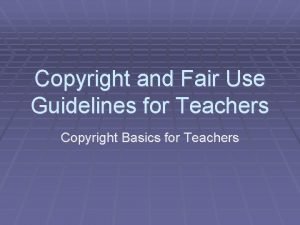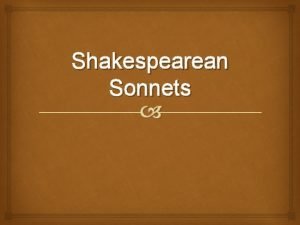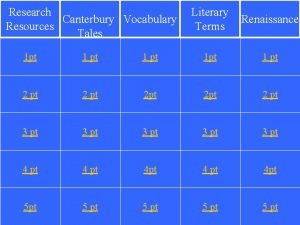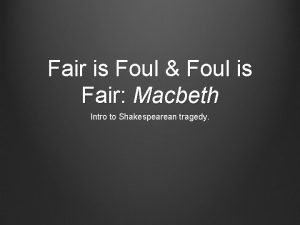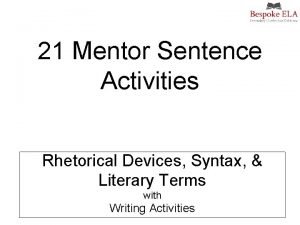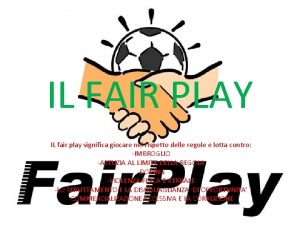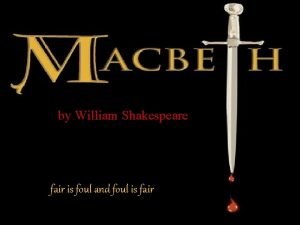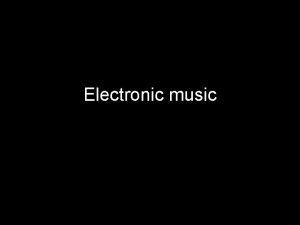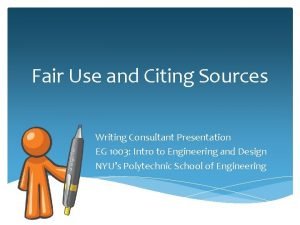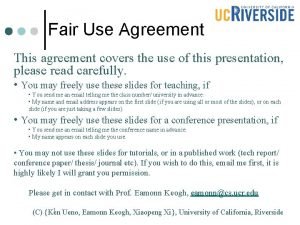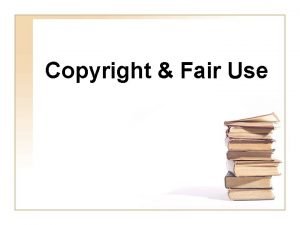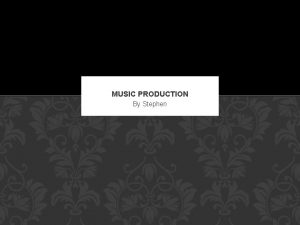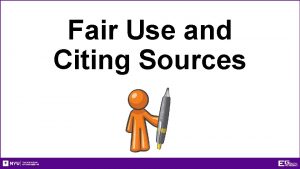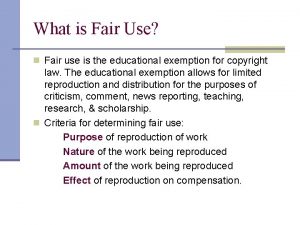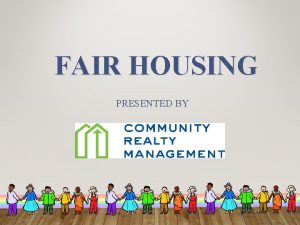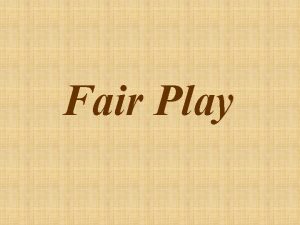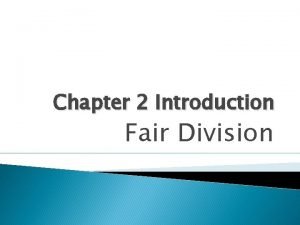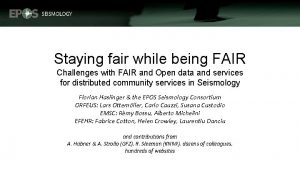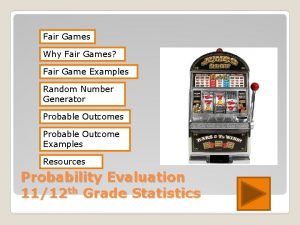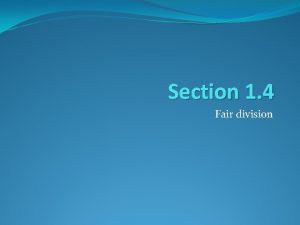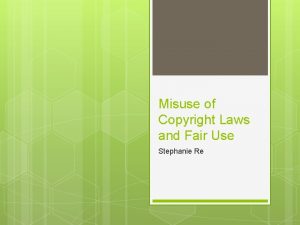Understanding Copyright Laws Fair Use FOR MUSIC PRODUCTION



















- Slides: 19

Understanding Copyright Laws & Fair Use FOR MUSIC PRODUCTION AND MUSIC PERFORMANCE By: Megan Endicott

Copyright Law of the United States Fair Use – Section 107 / Copyright Act Langwitches. “Copyright- Creative Commons- Fair Use- Public Domain. ” Flickr, Yahoo!, 12 Sept. 2009, www. flickr. com/photos/langwitches/3911878879.

Fair Use: • “PURPOSE AND CHARACTER OF THE USE” (COMMERCIAL OR NONPROFIT EDUCATION) • “NATURE OF COPYRIGHTED WORK” • “AMOUNT AND SUBSTANTIALITY OF THE PORTION IN RELATION” TO THE WHOLE • “EFFECT OF USE UPON THE POTENTIAL MARKET FOR OR VALUE OF” THE WORK Office, U. S. Copyright. “More Information on Fair Use. ” Copyright, U. S. Copyright Office, www. copyright. gov/fair-use/more-info. html.

Six Copyright Uses in Music Classroom: Reproducing Recording Derivative Works Distribution Performance Display Schlager, Ken. “National Association for Music Education (NAf. ME). ” NAf. ME, Apr. 2008, nafme. org/my-classroom/copyright-law-what-music-teachers-need-to-know/>.

Reproducing Review the Fair Use four factors Exception: “One copy per student up to 10 percent of a musical work for class study as long as 10 percent does not constitute a single performable unit” (Schlager, 2008).

• ABILITY TO MAKE A SINGLE RECORDING FOR ARCHIVAL OR EDUCATIONAL PURPOSES. • SINGLE COPY MADE FOR ASSESSMENT OR “AURAL EXERCISE” (SCHLAGER, 2008) • ALL OTHER RECORDINGS REQUIRE A LICENSE (COMPULSORY LICENSE) Recording

Derivative Works “You can rearrange, edit, or simplify a copyrighted work for educational purposes, provided you do not change ‘the fundamental character’ of the composition or alter or add lyrics” (Schlager, 2008) Contact publisher for significant changes Exception: “You can create a new arrangement of a composition for the purpose of recording that work for distribution” (compulsory license) (Schlager, 2008).

Distribution • FRAGMENTS ARE GENERALLY ALLOWED • SINGLE COPY OF RECORDING ALLOWED • DISTRIBUTION OF NEW RECORDINGS ALLOWED (COMPULSORY LICENSE)

Performance “Performance of copyright songs require license” (Schlager, 2008). Longer performances (musicals, dramas, ballets, etc. ) must obtain a license to perform live. Exemption: “Performing a song live to demonstrate technique during a music class or playing a song on CD as part of music history class, for example, would fall under this exemption” (Schlager, 2008).

Display • LEGALLY ACQUIRED MATERIALS MAY BE DISPLAYED

Check for understanding: understanding Complete the following scenarios to assess your understanding of copyright and fair use laws.

Scenario #1: Bob creates an amazing presentation, but all it needs is a little classic rock in the background to finalize his work. Bob had to use the entire song in his efforts to end at the same time as the slideshow presentation. Bob will only be sharing this video with the school. Has he violated copyright laws?

Scenario #1 Answer: Answer YES. BOB HAS VIOLATED COPYRIGHT LAW. “IN THE FOLLOWING FAIR USE GUIDELINES, MUSIC THAT IS APPLICABLE TO EDUCATION WOULD BE THAT WHICH IS DIRECTLY RELATED TO YOUR COURSE CONTENT” (BRITT, 2008). THIS TYPE OF BACKGROUND MUSIC IS NOT PART OF THE EDUCATIONAL LESSON.

Scenario #2: Sally purchased a piece of music from i. Tunes to use in her presentation. She was very excited that she complied with copyright laws by legally owning her song! She posted her final product for the public on You. Tube. Did Sally violate copyright laws?

Scenario #2 Answer: YES. SALLY’S LEGAL PURCHASE OF MUSIC IS FOR PERSONAL AND HOME USE ONLY. “LEGAL MUSIC PURCHASE IS FOR PERSONAL AND HOME USE, AND AN ENTIRELY NEW SET OF RULES APPLY FOR EDUCATION” (BRITT, 2008).

Scenario #3: Megan created a lesson for her students about classical composer, Beethoven. Part of her lesson was comparing and contrasting various works of Beethoven for specific musical elements. She included portions of three contrasting Beethoven pieces. Did Megan violate copyright laws?

Scenario #3 Answer: NO. MEGAN INCLUDED ONLY PORTIONS OF THE PIECES OF MUSIC AND THE MUSIC WAS DIRECTLY RELATED TO THE CONTENT.

Suggestions Educate When staff and students on copyright laws in doubt, request permission Purchase royalty-free music or search music in public domain. Compose/Create • your own music! (This is my favorite solution!) Britt, Barry S. “Copyright Issues When Using Music in Videos | Copyright | Legal / Grants. ” Lip. Dub 101 - Get Your Whole School Involved! | Activities / Projects | For Teachers, School Video News, Mar. 2008, schoolvideonews. com/Copyright-issues-when-using-music-in-videos.

References Britt, Barry S. “Copyright Issues When Using Music in Videos | Copyright | Legal / Grants. ” Lip. Dub 101 Get Your Whole School Involved! | Activities / Projects | For Teachers, School Video News, Mar. 2008, schoolvideonews. com/Copyright-issues-when-using-music-in-videos. “Copyright Law of the United States. ” Copyright, US Copyright Office, www. copyright. gov/title 17/. Langwitches. “Copyright- Creative Commons- Fair Use- Public Domain. ” Flickr, Yahoo!, 12 Sept. 2009, www. flickr. com/photos/langwitches/3911878879. Office, U. S. Copyright. “More Information on Fair Use. ” Copyright, U. S. Copyright Office, www. copyright. gov/fair-use/more-info. html. Schlager, Ken. “National Association for Music Education (NAf. ME). ” NAf. ME, Apr. 2008, nafme. org/myclassroom/copyright-law-what-music-teachers-need-to-know/>.
 Music copyright fair use
Music copyright fair use Copyright and fair use guidelines for teachers
Copyright and fair use guidelines for teachers Music music music
Music music music Pre production flow chart
Pre production flow chart Sonnet 14 lines examples
Sonnet 14 lines examples Foul is fair and fair is foul literary device
Foul is fair and fair is foul literary device Literary terms in macbeth
Literary terms in macbeth Foul is fair and fair is foul
Foul is fair and fair is foul Syntax literary device
Syntax literary device Fair is foul and foul is fair significato
Fair is foul and foul is fair significato Examples of fair is foul and foul is fair in macbeth
Examples of fair is foul and foul is fair in macbeth Facts about montesquieu
Facts about montesquieu Production copyright
Production copyright Romantic instruments
Romantic instruments Texture refers to loudness and quietness of music
Texture refers to loudness and quietness of music What music that employs electronic music
What music that employs electronic music This is the ilocano name for the wind instrument
This is the ilocano name for the wind instrument Fair use definition
Fair use definition Fair use
Fair use Fair use definition
Fair use definition

